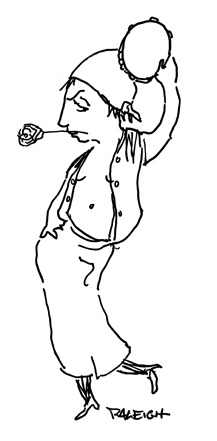Film:
 |
Sometimes Curmudgeons Laugh
By HENRY P. RALEIGH
ART TIMES Jan/ Feb 2011
Curmudgeons don’t often laugh. The older the curmudgeons the less likely they will laugh—except, perhaps, for the wrong reasons. Lillian Gish once described her film persona as funny as a barrel full of dead babies. Many curmudgeons will laugh at that. But in an unguarded moment recently I did laugh. I am quite certain I laughed while watching a 1928 silent comedy called “The Patsy.” Now film historians will tell you silent comedies are the finest form of comedy ever put on film and would be burned on a stake before admitting that most, at best, have more than an archaic, simple-minded charm. To test your endurance try, for example, “Tillies Punctured Romance” of 1914, an early Chapin film of historic importance and little of comedic value — unless you enjoy an endless and wearisome round of people pushing, shoving, slapping, tripping and falling down only to rise again to be pushed, shoved, slapped, tripped and fall down, pausing now and then to throw food at one another. Oh, I will sit through these silent, pure, finest comedies ever recorded by ancient cameras whenever they come around because that’s what you do if historic minded and wish to appear a smarty-pants. And then I came upon Marion Davies in “The Patsy.”
Most today probably remember the Marion Davies story from the cruelly inaccurate portrayal of her a Susan Alexander Kane, mistress of the newspaper tycoon, W. R. Hearst, in Orson Wells’ “Citizen Kane.” In fact Marion Davies was a most talented comedienne although, on Heart’s insistence, misplaced in romantic roles in mediocre films. Her beginnings in comedy film are largely forgotten. I can recall having seen only a few of Davies’ films made during that other Depression, one, “Going Hollywood”, mostly remembered as an early Bing Crosby and for a tune popular on radio back then — We’ll Make Hay While the Sun Shines (and We’ll Make Love When it is Raining— in case you wondered.) “The Patsy” however is full-blown Marion Davies at her peak, appealingly funny best. No matter this is a silent, one of the last to be made, with the usual sub-titles that all seem to be poorly written puns, Davies’ physical comedy is nearly a spoken language in itself. Her movements and facial expressions are marvelously elastic, sliding easily from pouting anger to indignation to sappy mooning (a love-sick expression, for you younger folks.) Her visual range included a variety of subtle gestures that rivaled those of Chaplin. It is no wonder that Chaplin was one of the few that recognized Marion Davies’ extraordinary talent for comedy. Here, in an effort to entice a drunken would-be suitor she first impersonates a Clara Bow flapper, frantically shimmying and doing a Charleston. Drawing no response she next tries Lillian Gish, downcast, forlorn eyes, “Orphan of the Storm” impersonation. This failing as well, she appears once more now as Theda Bara, vamping dramatically, rose between teeth. Each impersonation is dead-on, as good as Tina Fey’s Sarah Palin. And yes, I did laugh and not soundlessly I can tell you, scaring the cats.
If Marion Davies had been given clever lines to speak in “The Patsy” she might very well have continued into the 30’s earning a star position in the romantic-comedy genre as had Constance Bennett and Rosalind Russell. The nearest comparison in the modern era that comes to mind if Carol Burnett, also a master of comic mugging and physical expression. It’s too bad, I think, we have no such talents anymore. Well, if we did what would become of Adam Sandler?
